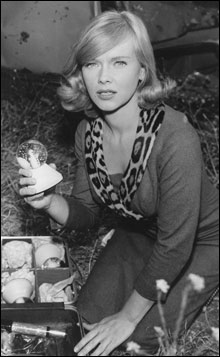
TOUGH DOLL: Anne Francis's Honey was an American wisecracker, her sarcasm masked with a faux sweet smile. |
I didn't see Honey West during its one-season, 1965-'66 prime-time run on CBS. I caught up with the show when the network used the 30 half-hour episodes as a daytime summer-replacement series a year or so later.The show fascinated me. To my five-year-old mind, this black-and-white world of detectives and gadgets and danger looked impossibly exciting. I couldn't imagine myself as Honey West, the detective hero played by the luscious Anne Francis — she was a girl. But just as generations of girls had imagined themselves the helpmate to various male heroes, I couldn't have been the only boy in America fantasizing himself as Honey's sidekick in danger.
As it turns out, there were young women already fantasizing themselves as Honey West. One Phoenix alum, inspired by Francis's ready-to-prowl wardrobe, confessed to me that she spent part of a Chelsea girlhood running around in black turtleneck and tights in emulation of her heroine. And on my third date with the woman whom I'd marry, she confessed that, 300 miles away from where I was growing up, she was watching Honey West as raptly as I was.
One season doesn't provide much in the way of reruns, so the show hasn't been syndicated in years. But now there's a four-disc set, Honey West: The Complete Series (VCI), that collects all the episodes.
Honey West originated in the '50s as a series of paperbacks written by a husband-and-wife team under the pseudonym G.G. Fickling. The novelty of the books was a female gumshoe (a police detective's daughter) in hard-boiled formula.
But by the time the series debuted, the James Bond craze had hit America. NBC had debuted The Man from U.N.C.L.E. the season before; ABC would import The Avengers the following year. And so the 1965 model Honey, though still a private eye with her own agency, came fully equipped with all sorts of gadgets and disguises and cool repartee. That last feature she shared with her partner, the phallically named Sam Bolt (John Ericson). For propriety's sake, Honey had acquired a live-in aunt (Irene Hervey, whose appearances are kept to a minimum) and, à la Jayne Mansfield, Bruce, a pet ocelot.
Produced on the cheap (by Aaron Spelling), and with some sets recycled from episode to episode, the show nonetheless retains some of its original cocktail-shaker-and-hidden-transistors glamour. The credit sequence alone is all the atmosphere you'd want, with its quickly glimpsed stills of Honey in hand-to-hand combat and Bruce baring his fangs, fetishistic attention paid to the mole just below the right side of Francis's mouth, and then the multiple images reflected in the facets of a diamond, all of it set to a pseudo-jazzy score. You fall in and out of the plots as you're watching. Somewhere in most of them, Honey is romanced by some seedy lothario whose Euroskank polish turns out to be a disguise for the sleazy job he's pulling.
What holds it together is Francis. She'd been kicking around movies since the '50s and been in some good ones (Forbidden Planet; Bad Day at Black Rock, in which she played co-star Ericson's sister), but she never made the impression she did in these 30 half-hours. The show displayed her ash-blond hair and sensational figure. But Honey wasn't an untouchable goddess — she was an American wisecracker, and Francis's sarcasm is never sharper than when she's masking it with a faux sweet smile.
For those who love it, part of the appeal of Honey West will always be its unfinished quality. The combination of the 30 slightly shabby episodes we're left with and the embellishment it took on in our imaginations is the stuff of which lifelong devotion is made.